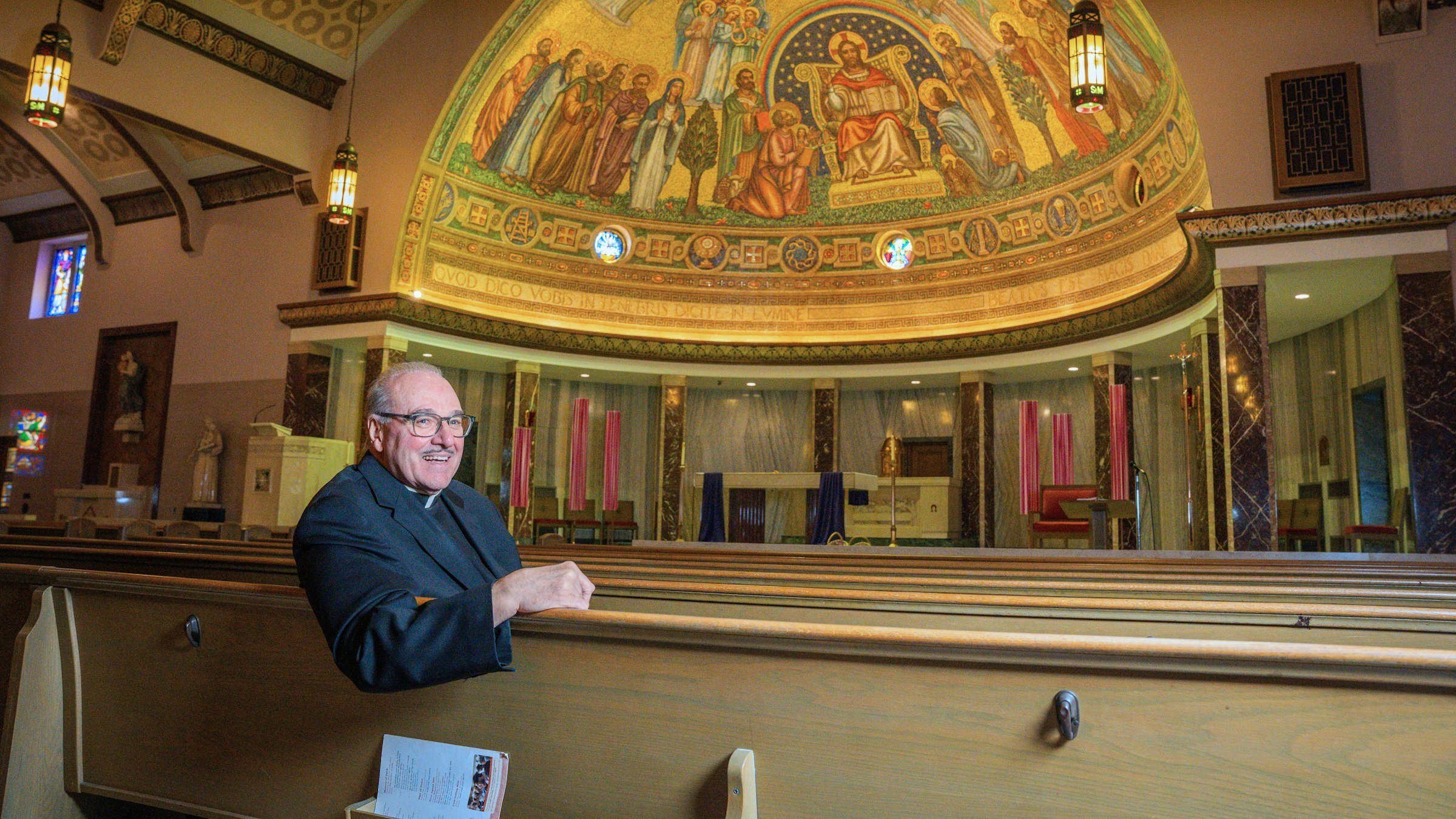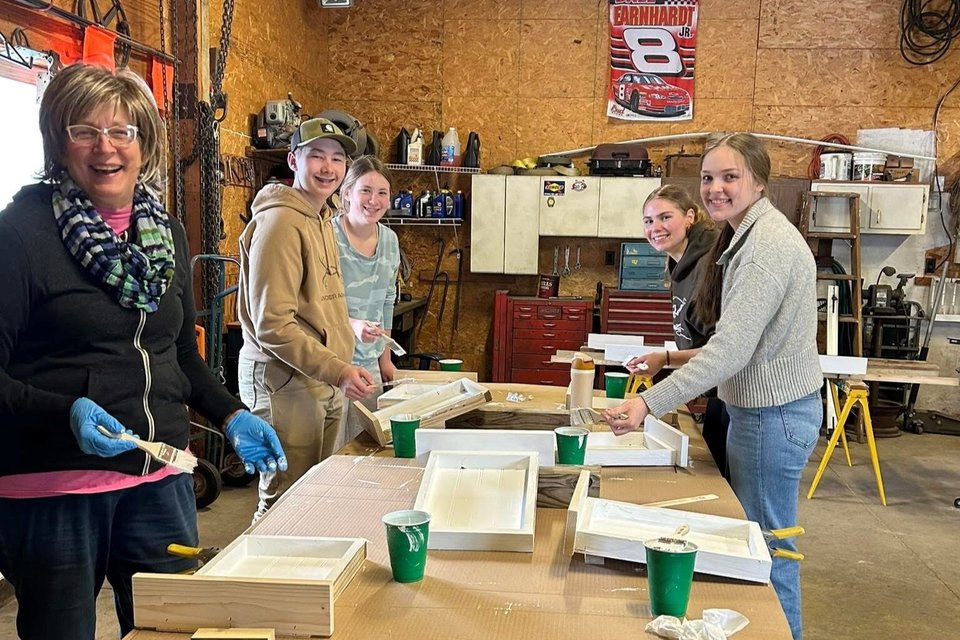Church built 1954 among newest entries to National Register of Historic Places, including famed mosaic of Christ the King
DETROIT — St. Matthew parishioners always knew their church was special.
The Tudor revival, early modern movement church has a sandstone façade and an imposing presence on Harper Avenue and Whittier Street, overlooking Interstate 94 at the crossroads of Detroit’s Morningside, East English and Yorkshire Woods neighborhoods.
For east-siders, St. Matthew Church stands as a marking point — where Detroit ends and the Grosse Pointes and St. Clair Shores begin.
Don't miss another story
Did you know you can get Detroit Catholic's latest daily or weekly articles delivered to your inbox? It's easy and free to sign up.
Now, the parish is in the national spotlight.
In November 2023, St. Matthew Parish was placed on the National Park Services’ National Register of Historic Places, the 29th Catholic site in the city of Detroit to be listed on the U.S. Department of the Interior’s list, but the first to be classified in the early modern architectural period.
“It gives us national recognition for the history of the parish,” said Fr. Duane Novelly, who has served at St. Matthew Parish since 1989. “Being here in this location for almost 100 years now, and as we are preparing to celebrate that centennial, this is a real recognition of our church building as it stands now. It’s quite a nod to the way in which the complex has been maintained and is still a viable community of faith that lives in it.”

The current St. Matthew Church was built in 1954 — the parish was founded in 1926 — under the direction of Fr. Joseph Fillion, who succeeded the founding pastor, Fr. James. P. Welsh.
The church is part of the early modern movement of church architecture, a Romanesque style built of granite, marble and stone, in a traditional cruciform design, but has a modern look with clean lines and rounded features.
St. Matthew maintains the traditional look of when the church was first built, with renovations being completed in 1972 to algin with the liturgical reforms of the Second Vatican Council, mainly, removing the baldachino canopy that was placed over the original altar, in order to move the altar to the center of the sanctuary so the priest could face the congregation during Mass.
“The baldachino was removed in 1972 as they brought the altar out, but they did a marvelous job on maintaining the integrity of the sanctuary, so much so that the current legs of the altar are part of the columns of the original baldachino,” Fr. Novelly told Detroit Catholic. “But in talking about the more traditional elements, what gives it a modern flavor is the lines are very clean; there is no ‘clutter’ in the church. Even the artwork is done very well with very clean lines.”
Similar churches of the same style in the archdiocese include St. James Church in Ferndale and St. Jude in Detroit that were built as the city’s population was expanding its footprint outward from the original city limits.

“This church represents the evolution of church construction around Detroit over the course of the last 50 years,” said David Smydra, a St. Matthew parishioner who has served on the parish council, finance commission and helped with the recent sale and transition of St. Matthew’s former school building and activity hall into affordable housing. “It’s described as part of the transitional architectural movement. The original Catholic churches that have historical designations are more in the central city or downtown, very reflective of European-style architecture. As Detroit expanded, particularly in the 1920s and '30s, moving into the time we represent, there was a new movement in architecture that was called the modern movement.”
The modern movement led to the building of more Romanesque-type churches, with straight columns and curved ceilings, as opposed to the more traditional Gothic churches with pointed features.
The report submitted by the National Park Service paid particular attention to the 1,300-square-foot mosaic, “Christ the Lord of the Universe,” created by artisan Andrew Maglia, which features a seated Christ surrounded by the four evangelists with their respective symbols — a winged man, a winged ox, a winged lion and an eagle — and 10 other apostles along with Mary and Joseph.

“The one element that really stands out is the mosaic dome,” Fr. Novelly said. "It’s the focal point of the church that surrounds the altar and the sanctuary. The dome is an original piece of art done by Andrew Maglia, and it’s all mosaic, with over a million little tiles. It has a theme of Jesus Christ, Lord of the Universe, with Christ sitting on His throne, surrounded by evangelists, because the theme of all the artwork is evangelization, particularly because the church is dedicated to St. Matthew, one of the writers of the Gospels.”
The report also highlighted Maglia’s stained-glass windows, with the lower level depicting the life of Christ and the upper level depicting the life of St. Matthew, and the separate baptistery in the narthex of the church, which was a common feature in churches built before St. Matthew, Fr. Novelly said, reflective of a theology where the initiated are first baptized before coming into the church.
Discussion about getting the parish on the national historic registry began in earnest around 2020, when plans for the Residency at St. Matthew’s were being discussed.
“Over the last 25 years, there has always been discussion around how beautiful this church is, how beautiful this setting is and what can we do to preserve it,” Smydra said. “Then the opportunity arose in 2020 to consider the sale of what were formerly the school building and the activity building, having those transition to affordable housing.”

A historical designation not only recognizes the significance of St. Matthew Church, but being on the national historic registry makes the parish eligible for tax credits to finance the transition of the buildings and allows the parish to explore preservation grants in the future.
When the National Park Service and the Michigan Historical Commission released the 19 new historical designations in November, St. Matthew’s was on the list, with a photo of the “Christ the Lord of the Universe” mosaic featured prominently in the media release.
St. Matthew is the 29th Catholic building or campus in the city of Detroit to make the National Register of Historic Places. There are 39 Catholic churches, sites, buildings or campuses in the Archdiocese of Detroit on the list.
The national registry is separate from the Michigan Historical Marker Program, which features more than 1,700 green historical markers throughout the state. The national registry is under the U.S. Department of the Interior and requires a yearslong investigation into a site's cultural significance, current usage and historical authenticity.

A marker commemorating St. Matthew’s place on the National Register of Historic Places will arrive from the Department of the Interior soon.
For Fr. Novelly, the designation is a testament not only to the skill and craftsmanship of those who built St. Matthew Church in 1954, but the faith and dedication of the people today who maintain the church and make it a vibrant center of evangelization.
St. Matthew has seen — and continues to see — much change in its surrounding community, including the Residency of St. Matthew, which is slated to be completed by December 2024.
“The parishioners were delighted when they found out we were placed on the National Register of Historic Places; it’s a real source of pride,” Fr. Novelly said. “The parishioners have worked very hard and diligently in terms of their support, not only financially, but in supporting our programming, our liturgies and the campus itself.”
For longtime parishioners like Smydra, the historical designation is more than a testiment to the longevity of the parish; it’s a promise reflected in the parish's 50th anniversary motto, “Here to stay,” and its 75th anniversary motto, “What was and is and will be.”
"There really has been a strong commitment by our core parishioners over many years to maintain and keep this facility in good shape,” Smydra said. “To have that rewarded and recognized by a national program like the National Historic Registry is a significant thing."
National Register of Historic Places
There are 39 Catholic churches, sites, buildings or campuses in the Archdiocese of Detroit listed on the National Register of Historic Places. They are:
Lapeer County
- Piety Hill Historic District (including Immaculate Conception Church), Lapeer
Macomb County
- Romeo Historic District (including St. Clement Church)
Oakland County
- Downtown Holly Commercial District (including St. Rita Church)
- Orchard Lake Schools Historic District, Orchard Lake
- St. Vincent de Paul Catholic Church, Convent and School, Pontiac
Wayne County
- Academy of the Sacred Heart, Grosse Pointe Farms, Grosse Pointe Academy
- Assumption of the Blessed Virgin Mary Church Complex, Detroit
- Cathedral of the Most Blessed Sacrament, Detroit
- Corktown Historic District (including Most Holy Trinity Church), Detroit
- Chapel of St. Theresa the Little Flower, Detroit (St. Patrick’s Church)
- Church of the Transfiguration Historic District, Detroit
- Greektown Historic District (including Old St. Mary's Church), Detroit
- Immaculata High School, Detroit
- League of Catholic Women Building, Detroit
- Marygrove College, Detroit
- Palmer Woods Historic District (including Bishop Gallagher Residence), Detroit
- Sacred Heart Roman Catholic Church, Convent and Rectory, Detroit
- Sacred Heart Major Seminary, Detroit
- St. Joseph Roman Catholic Parish Complex, Detroit
- St. Matthew Parish, Detroit
- St. Paul Catholic Church Complex, Grosse Pointe Farms
- SS. Peter and Paul (Jesuit), Detroit
- St. Albertus Roman Catholic Church, Detroit
- St. Bonaventure Monastery, Detroit
- St. Catherine of Siena Roman Catholic Parish Complex, Detroit
- St. Charles Borromeo Roman Catholic Church Parish Complex, Detroit
- St. Florian Historic District, Hamtramck
- St. Josaphat’s Roman Catholic Church Complex, Detroit
- Holy Rosary Catholic Church (Listed at St. Joseph’s Episcopal Church)
- St. Stanislaus Bishop and Martyr Roman Catholic Parish Complex
- St. Theresa of Avila Roman Catholic Parish Complex, Detroit
- St. Thomas the Apostle Catholic Church and Rectory, Detroit
- Ste. Anne Roman Catholic Church Complex, Detroit
- Sts. Peter and Paul Academy, Detroit
- Sweetest Heart of Mary Roman Catholic Church, Detroit
- Washington Boulevard Historic District (including St. Aloysius Church), Detroit
- West Vernor-Junction Historic District (including Most Holy Redeemer Church), Detroit
Monroe County
- St. Mary’s Academy History District, Monroe
- St. Mary’s Church Complex Historic District, Monroe
Copy Permalink
History Parish life












